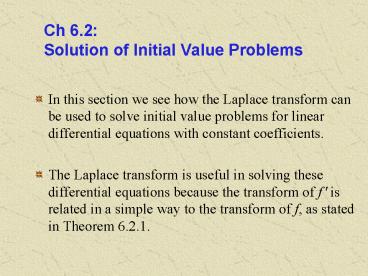Ch 6'2: Solution of Initial Value Problems - PowerPoint PPT Presentation
1 / 14
Title:
Ch 6'2: Solution of Initial Value Problems
Description:
... value problems for linear differential equations with constant coefficients. ... has the Laplace transform F(s), since L is linear. ... – PowerPoint PPT presentation
Number of Views:63
Avg rating:3.0/5.0
Title: Ch 6'2: Solution of Initial Value Problems
1
Ch 6.2 Solution of Initial Value Problems
- In this section we see how the Laplace transform
can be used to solve initial value problems for
linear differential equations with constant
coefficients. - The Laplace transform is useful in solving these
differential equations because the transform of f
' is related in a simple way to the transform of
f, as stated in Theorem 6.2.1.
2
1/ Theorem 6.2.1 Laplace tranform of f
- Suppose that
- (1) f is continuous and f ' is piecewise
continuous on 0, b for all b gt 0. - (2) f(t) ? Keat when t ? M, for constants a,
K, M, with K, M gt 0. - Then the Laplace Transform of f ' exists for s gt
a, with
3
Corollary 6.2.2
- Suppose that f is a function for which the
following hold - (1) f , f ', f '' ,, f (n-1) are continuous,
and f (n) piecewise continuous, on 0, b
for all b gt 0. - (2) f(t) ? Keat, f '(t) ? Keat , , f
(n-1)(t) ? Keat for t ? M, for constants a, K,
M, with K, M gt 0. - Then the Laplace Transform of f (n) exists for s
gt a, with - For f ''
4
a/ Example 1
2/ Laplace Tranform Method
- Consider the initial value problem
- From section 3.1
- We now solve this problem using Laplace
Transforms.
5
- Assume that our IVP has a solution ? and that
?'(t) and ?''(t) satisfy the conditions of
Corollary 6.2.2. Then - and hence
- Letting Y(s) Ly, we have
- Substituting in the initial conditions, we obtain
- Thus
6
- Using partial fraction decomposition, Y(s) can be
rewritten - Thus
7
- Recall from Section 6.1
- Thus
- Recalling Y(s) Ly, we have
- and hence
8
b/ General Laplace Transform Method
- Consider the constant coefficient equation
- If we let Y(s) Ly and F(s) L f , then
9
(Inverse Problem and Uniqueness)
- The main difficulty in using the Laplace
transform method is determining the function y(t)
such that Ly(t) Y(s), - this is an inverse problem, in which we try to
find y such that - f(t) L-1Y(s) inverse transform of Y(s).
- It can be shown that if y(t) is continuous with
Ly(t) F(s), then y(t) is the unique
continuous function with y (t) L-1F(s). - There is a one-to-one correspondence between the
functions and their transforms gt See Table
6.2.1.
10
Linearity of the Inverse Transform
- Frequently a Laplace transform F(s) can be
expressed as - Let
- Then the function
- has the Laplace transform F(s), since L is
linear. - And (by the uniqueness result of the previous
slide) no other continuous function f has the
same transform F(s). - Thus L-1 is a linear operator with
11
Example 2 Nonhomogeneous Problem (1 of 2)
- Consider the initial value problem
- Taking the Laplace transform of the dif. eq. (and
assuming the conditions of Corollary 6.2.2 are
met) we have - Letting Y(s) Ly, we have
- Substituting in the initial conditions, we obtain
- Thus
12
Example 2 Solution (2 of 2)
- Using partial fractions,
- Then
- Solving, we obtain A 2, B 5/3, C 0, and D
-2/3. Thus - Hence
13
Example 3 Solving a 4th Order IVP (1 of 2)
- Consider the initial value problem
- Taking the Laplace transform of the differential
equation (and assuming the conditions of
Corollary 6.2.2 are met) we have - Letting Y(s) Ly and substituting the initial
values, we have - Using partial fractions
- Thus
14
Example 3 Solving a 4th Order IVP (2 of 2)
- Solving, we obtain a b 1/2
- Thus
- Using Table 6.2.1, the solution is































